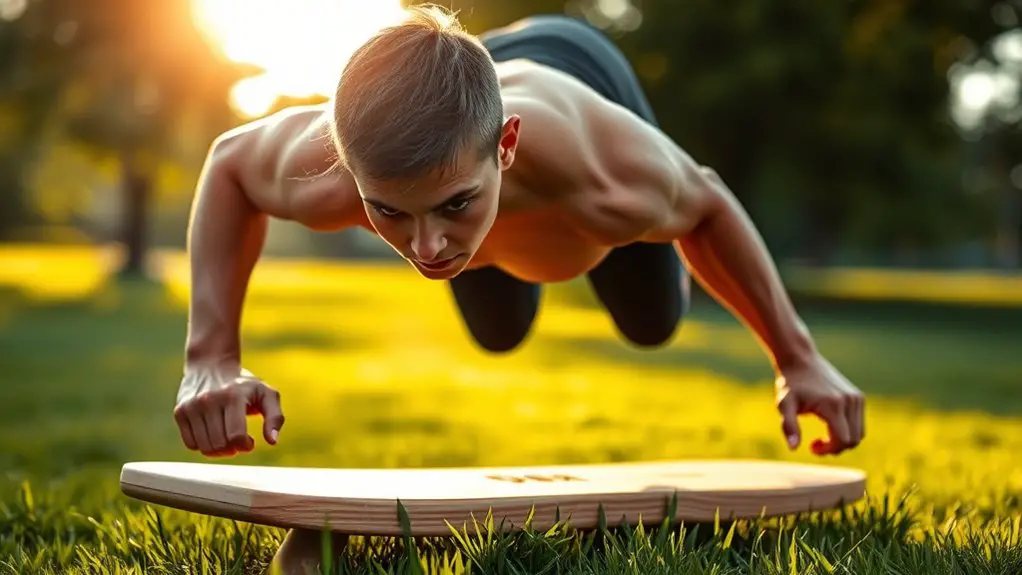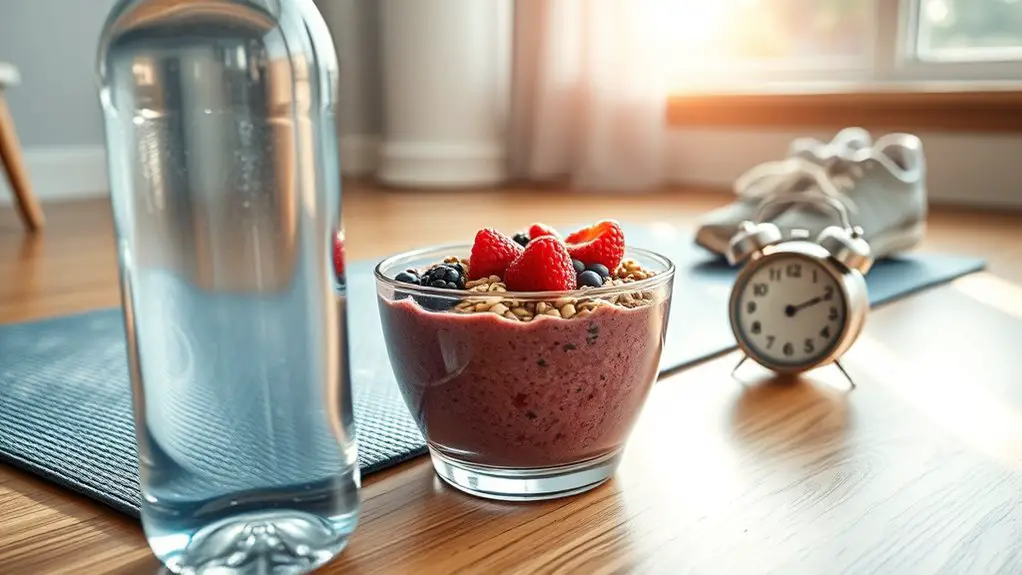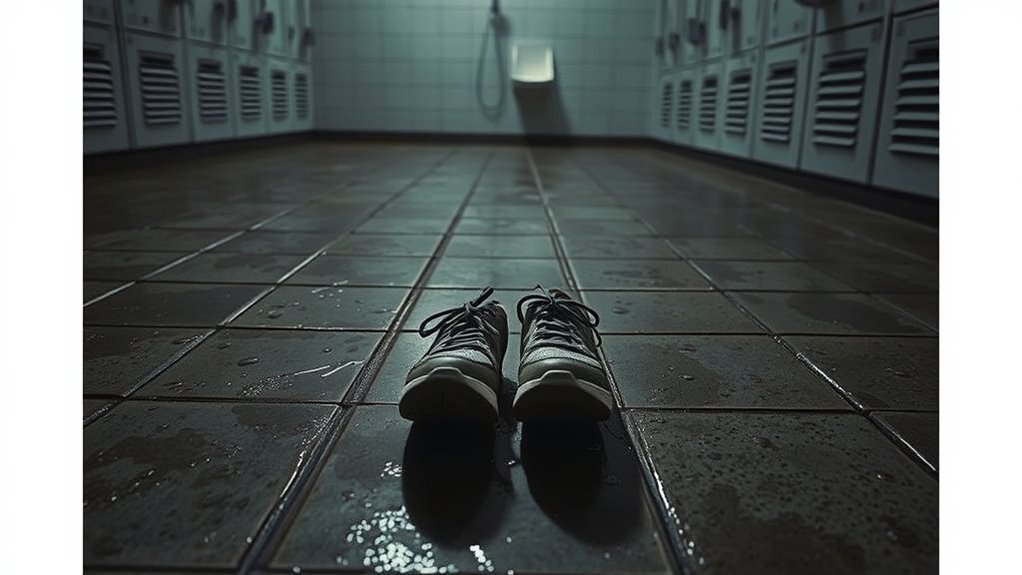Training on unstable surfaces improves your balance by enhancing your proprioception. When you exercise on tools like balance boards or stability balls, your body engages key stabilizing muscles, increasing coordination and core strength. This heightened awareness helps you react faster and maintain control during movement. Plus, it reduces your risk of injury, giving you more confidence. If you want to discover the different exercises and techniques that can further enhance your balance, there's more to explore.
Understanding Balance and Stability
Balance and stability are essential components of physical fitness that affect everything from daily activities to athletic performance. When you think about it, having good balance lets you move freely without fear of falling or getting hurt. It's not just about standing still; it's about how well you can control your body during movement. Whether you're walking, running, or dancing, stability allows you to express yourself fully and enjoy every moment.
Understanding the fundamentals of balance means recognizing how your body interacts with gravity. It's all about finding that sweet spot where you feel grounded yet agile. Improving your balance and stability opens up a world of possibilities, from exploring new hobbies to engaging in sports you love. Additionally, incorporating mobility training into your routine can significantly enhance your overall balance. So, embrace the journey of enhancing your balance; it's a step toward greater freedom and empowerment in every aspect of your life. Remember, the stronger your balance, the freer you'll feel!
The Role of Proprioception
Your proprioceptive system plays an essential role in maintaining balance by helping you sense your body's position in space. When you train on unstable surfaces, you're enhancing this awareness, which can lead to better overall stability. Understanding how this system works can highlight the benefits of incorporating such training into your routine.
Proprioceptive System Explained
The proprioceptive system acts like an internal GPS, helping the body understand its position and movement in space. It's essential for achieving the freedom to move confidently and fluidly. By honing this system, you can enhance your physical capabilities and balance. Here's how it works:
- Sensory Feedback: Your muscles and joints send signals to your brain about their position and movement.
- Coordination: This feedback allows your brain to coordinate muscle action, making your movements smoother and more controlled.
- Balance: With improved proprioception, you'll find it easier to maintain balance, even on unstable surfaces, empowering you to explore new physical challenges with confidence.
Embracing your proprioceptive abilities opens up a world of movement possibilities!
Benefits of Enhanced Awareness
Enhanced awareness through improved proprioception can markedly transform your physical performance. When you train on unstable surfaces, you're not just balancing; you're tuning into your body's signals. This heightened awareness helps you recognize subtle shifts in weight and position, allowing for quicker reactions and better control. Imagine moving freely, whether you're playing sports or simply maneuvering through your daily life. With enhanced proprioception, you'll feel more grounded and confident, reducing the risk of falls and injuries. You'll also discover new ways to engage your muscles, fostering strength you didn't know you had. Ultimately, this awareness grants you the freedom to explore your physical capabilities, empowering you to embrace challenges and enjoy every moment with renewed vigor.
Benefits of Unstable Surface Training
Although many people focus on traditional strength training methods, incorporating unstable surface training can greatly enhance your overall balance and stability. By challenging your body in new ways, you'll reveal a range of benefits that promote freedom in movement and activity. Here are three key advantages:
- Improved Coordination: Training on unstable surfaces forces your body to engage multiple muscle groups, enhancing coordination and control.
- Increased Core Strength: This type of training activates your core muscles more effectively, giving you a solid foundation for all physical activities.
- Enhanced Proprioception: Unstable surfaces heighten your awareness of body positioning, which helps prevent injuries and boosts your confidence during dynamic movements. Additionally, prioritizing mobility training can further support your balance and stability by enhancing your range of motion.
Types of Unstable Surfaces
Incorporating unstable surfaces into your training routine can take your balance improvement to the next level. You'll find a variety of surfaces that can challenge your equilibrium and enhance your skills. Here's a quick look at some popular options:
| Surface Type | Description | Benefits |
|---|---|---|
| Bosu Ball | Half stability ball | Engages core, improves stability |
| Balance Board | Wooden or plastic platform | Enhances coordination |
| Foam Pad | Soft, squishy surface | Increases proprioception |
| Stability Ball | Inflatable ball | Strengthens core muscles |
| Wobble Cushion | Inflatable with an unstable base | Boosts balance and agility |
Experimenting with these surfaces not only keeps your workouts fresh, but it also empowers you to explore your limits. Additionally, training on unstable surfaces enhances proprioceptive abilities, allowing for better body awareness and injury prevention. So, get ready to take your training to new heights!
Key Muscles Engaged During Training
When you train on unstable surfaces, you engage key muscles that play an essential role in balance. Your core stability gets a significant boost, while your lower limbs strengthen to better support your movements. Understanding these muscle groups can help you maximize your training benefits. Engaging the core improves movement efficiency, minimizing injury risks during dynamic activities.
Core Stability Enhancement
Training on unstable surfaces markedly enhances core stability by engaging key muscle groups that play an essential role in maintaining balance. By focusing on these muscles, you're not just improving your stability; you're also gaining the freedom to move confidently in various activities. Here are three primary muscle groups involved:
- Transverse Abdominis: This deep core muscle acts like a natural weight belt, stabilizing your spine.
- Rectus Abdominis: Strengthening this muscle helps maintain proper posture while you navigate uneven terrain.
- Obliques: Engaging these muscles promotes rotational stability, essential for activities like dancing or sports.
Lower Limb Strengthening
While you might not realize it, strengthening your lower limbs is essential for overall balance, especially when training on unstable surfaces. Engaging key muscles like your quadriceps, hamstrings, calves, and glutes not only builds power but also enhances stability. When these muscles are strong, you've got a solid foundation, allowing for greater freedom of movement.
Exercises like lunges, squats, and calf raises become even more effective on unstable surfaces, pushing your muscles to adapt and grow. This adaptability is vital for maintaining balance in everyday activities. So, by focusing on lower limb strengthening, you're not just working out; you're empowering yourself to navigate life's challenges confidently and freely. Embrace the journey and feel the difference in your balance and strength!
How to Safely Incorporate Unstable Training
To safely incorporate unstable training into your routine, it's crucial to start gradually and listen to your body. Embrace the journey of enhancing your balance with these simple steps:
- Begin with Basic Movements: Start on stable surfaces with exercises like squats or lunges. Once you feel confident, shift to unstable surfaces like balance pads or wobble boards.
- Increase Difficulty Slowly: Once you've mastered basic movements, introduce challenges like single-leg stands or dynamic movements on unstable surfaces. This keeps your body engaged without overwhelming it.
- Prioritize Safety: Always have a support system nearby, like a wall or sturdy chair, especially when trying new exercises. It's about freedom, but safety should always come first. Additionally, implementing balance challenges on unstable surfaces can enhance performance and further develop your skills.
Sample Exercises on Unstable Surfaces
Incorporating exercises on unstable surfaces can greatly enhance your balance and stability. These exercises challenge your core and improve proprioception, giving you a sense of freedom in movement. Here are some sample exercises to get you started:
| Exercise | Description |
|---|---|
| Single-leg Stand | Balance on one leg for 30 seconds. |
| BOSU Ball Squats | Perform squats on a BOSU ball. |
| Stability Ball Push-ups | Do push-ups with hands on a stability ball. |
| Wobble Board Lunges | Lunge while balancing on a wobble board. |
| Balance Beam Walk | Walk heel-to-toe on a balance beam. |
These exercises are fun and can be easily integrated into your routine. Start slowly, and as you build confidence, increase the difficulty. Additionally, these exercises can help with injury prevention by addressing potential movement dysfunctions that may affect your overall performance. Embrace the freedom that comes from mastering your balance!
Progress Tracking and Goal Setting
Tracking your progress and setting goals are essential steps in enhancing your balance training. By keeping an eye on your achievements, you'll feel more motivated and empowered. Here's how you can effectively track your progress and set achievable goals:
- Keep a Journal: Document your workouts, noting the exercises, duration, and how you felt. This helps you see improvements over time.
- Set Specific Milestones: Instead of vague goals, aim for specific targets, like balancing on one leg for 30 seconds or completing a certain number of reps on an unstable surface.
- Schedule Regular Check-Ins: Every few weeks, reassess your progress. Celebrate small victories and adjust your goals as needed to keep your journey exciting. Additionally, tracking your progress aligns with setting realistic goals, which is essential for building self-confidence in sports.
Additional Tips for Enhanced Balance Training
While you've already made strides in tracking your progress, there are more ways to elevate your balance training. Integrate dynamic movements like lunges and squats on an unstable surface to challenge your body further. Try closing your eyes during exercises; it heightens your awareness and forces your balance to adapt. Mixing in yoga or Pilates can also enhance core strength, which is essential for stability.
Don't forget about your footwear; wearing shoes with minimal support can help you engage stabilizing muscles more effectively. Set aside time for flexibility training, as increased range of motion can boost your balance. Additionally, incorporating functional strength training into your routine can provide a solid foundation for improved balance. Finally, make it fun! Incorporate activities like dancing or outdoor adventures, which not only improve balance but also give you that sense of freedom you crave. Embrace variety and keep your training exciting, and you'll see even greater improvements in your balance journey.
Frequently Asked Questions
Can Unstable Surface Training Prevent Injuries During Sports Activities?
Yes, unstable surface training can help you prevent injuries during sports activities. It challenges your body's stability, enhancing your balance and coordination, which ultimately reduces the risk of falls and strains while you're active.
How Often Should I Train on Unstable Surfaces for Optimal Results?
Think of training on unstable surfaces like dancing on a tightrope; you'll want to practice 2-3 times a week for ideal results. Balance needs consistent attention, so embrace the freedom to explore and improve!
Is Unstable Surface Training Suitable for Older Adults?
Absolutely, unstable surface training can be beneficial for older adults. It enhances stability and strength, reducing fall risk. Just make certain you start slowly and listen to your body to enjoy the freedom of movement safely.
What Equipment Is Needed for Unstable Surface Training?
You don't need fancy equipment for unstable surface training. A balance board, wobble cushion, or even a sturdy pillow can work wonders. These tools let you enhance your stability while enjoying the freedom to move confidently.
Can I Combine Unstable Surface Training With Other Workout Routines?
Absolutely, you can mix unstable surface training with other workouts! Just be mindful of your body's limits. Combining them can enhance overall strength and coordination, giving you that freedom to explore diverse fitness routines. Enjoy!




